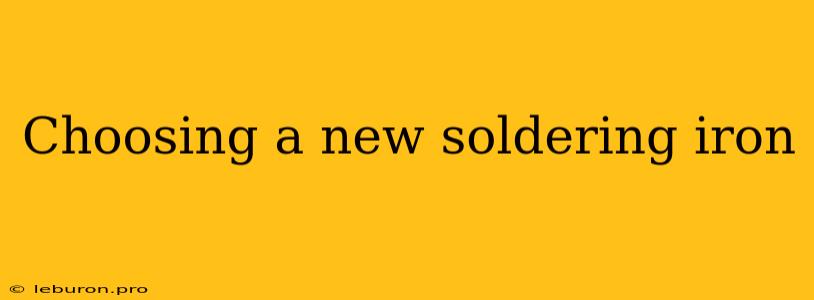Choosing the right soldering iron is essential for any electronics enthusiast, hobbyist, or professional. With so many options available on the market, it can be overwhelming to decide which soldering iron best suits your needs. This guide will cover essential factors to consider when choosing a new soldering iron, helping you make an informed decision and find the perfect tool for your projects.
Types of Soldering Irons
Soldering irons come in various shapes and sizes, each designed for specific applications. Understanding the different types will help you narrow down your options.
1. Pencil Soldering Irons
The most common type, pencil soldering irons, are versatile and suitable for a wide range of soldering tasks. They are typically lightweight and have a replaceable tip, making them easy to use and maintain.
2. Soldering Stations
Soldering stations offer greater control and precision than traditional pencil irons. They typically include a temperature-controlled base unit, a soldering iron, and various accessories like stands and tip cleaners. Soldering stations allow you to set a specific temperature, ensuring consistent results.
3. Temperature-Controlled Soldering Irons
These soldering irons combine the portability of a pencil iron with the temperature control of a soldering station. They often have a digital display for precise temperature adjustments and feature replaceable tips.
Factors to Consider When Choosing a Soldering Iron
1. Power and Temperature
The power of a soldering iron determines its ability to heat up quickly and maintain a stable temperature. A higher wattage iron heats up faster and can handle larger projects. The ideal power for a soldering iron depends on the type of work you'll be doing. For general electronics work, a soldering iron between 15 and 40 watts is suitable.
Consider the temperature the iron reaches as well. Soldering irons typically operate between 300°F and 900°F (150°C and 480°C). The best temperature will depend on the type of solder and the components you are working with.
2. Tip Size and Shape
The tip size and shape are critical factors affecting how well the heat is transferred to the joint and how precise your work can be. For fine detail work, use a smaller tip. For larger components, choose a larger tip to distribute the heat more effectively.
3. Tip Material
Soldering iron tips are made from different materials, including copper, nickel, and iron. Copper tips are the most common and offer good heat transfer. Nickel-plated tips are more durable and resistant to oxidation, while iron tips are less expensive but may not last as long.
4. Ergonomics
A comfortable grip is important for long soldering sessions. Choose a soldering iron with a comfortable handle and appropriate weight.
5. Features and Accessories
Some soldering irons offer additional features, such as adjustable temperature settings, automatic shut-off, and a stand for placing the iron when not in use. Accessories such as tip cleaners, tweezers, and soldering wire holders can make soldering easier and more efficient.
Choosing the Right Soldering Iron for Your Needs
1. Beginner Soldering
If you are new to soldering, a basic pencil soldering iron with a temperature control feature will provide you with all the tools you need to get started. Look for a model with a comfortable grip and a few different tip sizes.
2. Hobbyist Soldering
For hobbyists who require more precision and control, a temperature-controlled soldering station with adjustable temperature settings and a selection of tips is an excellent choice.
3. Professional Soldering
Professional soldering requires high-performance tools with reliable temperature control and durable construction. Look for a soldering station with a wide range of features and a robust design.
Maintenance and Safety
1. Tip Cleaning
Regularly clean your soldering iron tip to remove any residues that can build up and impede heat transfer. Use a damp sponge or a specialized tip cleaner.
2. Tinning
Tinning a soldering iron tip involves coating it with a thin layer of solder. This helps prevent oxidation and improves heat transfer.
3. Safety Precautions
Always be aware of the potential dangers of working with hot soldering irons. Wear safety goggles, gloves, and fire-resistant clothing to protect yourself from burns and fumes.
4. Storing Your Soldering Iron
When not in use, store your soldering iron in a safe place to prevent accidental burns.
Conclusion
Choosing the right soldering iron is crucial for successful soldering projects. Consider the factors discussed above, from the type of soldering iron to its power, temperature, and features. By selecting a suitable soldering iron and using it safely, you can create excellent results for your electronics projects and enhance your skills. Remember to take your time, research your options, and invest in a soldering iron that will meet your needs and allow you to confidently tackle any project.
